Ready to brighten up your shade garden? Let’s explore yellow hostas, luminous beauties that add unexpected pops of color. Regardless of garden size or your experience level, yellow hostas can be the golden ticket to an outshining display. Let’s delve in and elevate your garden with these radiant perennials. Let’s get growing!
Yellow hostas are perennial plants renowned for their vibrant yellow leaves. These plants enliven shady garden areas and are valued for their hardiness and ease of growth. Available in sizes from miniature to giant, they require morning sun and afternoon shade for optimal health and color.
Origin and Development of Yellow Hostas
Looking back in history we can find several hosta species have produced yellow seedlings or sports that can be traced back to the 1800s in Japan. My knowledge of this early history is almost non-existent. So…
Jumping into more modern times, let’s look at two yellow hostas from the 1970s that are still popular today:
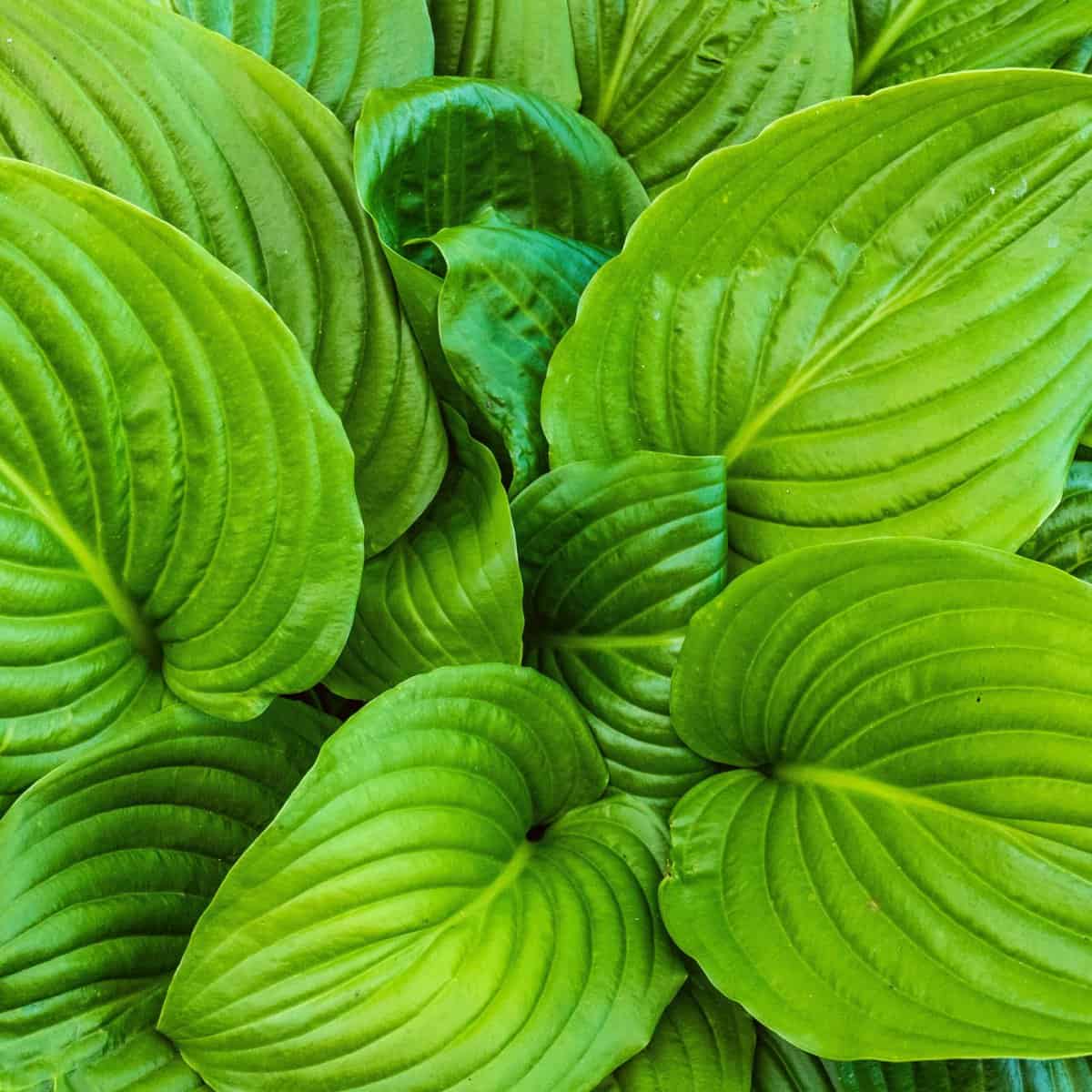
‘August Moon’ Hosta
Introduced in the 1970s, ‘August Moon’ is one of the first yellow hostas available to gardeners. This cultivar is known for its large, heart-shaped, seersucker-textured leaves that are beautiful, bright yellow. It’s a medium-sized hosta that forms an impressive mound and produces pale lavender flowers in the summer.
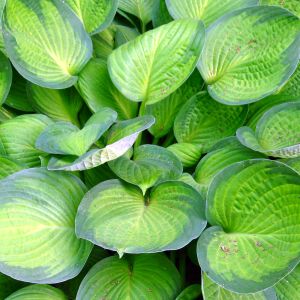
‘Gold Standard’ Hosta
This is another early yellow hosta cultivar that remains popular today. ‘Gold Standard’ was introduced in the late 1970s. Its striking foliage changes from chartreuse in spring to golden-yellow in summer. It’s also known for its larger size and impressive tolerance to various light conditions.
These two cultivars set the gold standard (pun intended) for yellow hostas. They paved the way for the many other yellow or gold hostas in gardens today.
Some Popular Varieties of Yellow Hostas
‘Cheatin Heart’ Hosta – Miniature, featuring bright golden-yellow heart-shaped leaves, forming a dense mound of cheery foliage. Makes a great ground cover.
‘Dancing Queen’ Hosta – Large, flaunts heart-shaped yellow leaves that seem to twirl and dance in the garden. Needs some sun to maintain its yellow color.
‘Daybreak’ Hosta – Large, presents leaves that change from chartreuse to bright gold, greeting the day with a radiant smile. Resistant to burning. Grows low and wide, unusual for a hosta.
‘Designer Genes’ Hosta – Small, displaying unique bright yellow foliage complemented by striking purple-red petioles, adding visual interest. Fast Grower. Viridescence.
‘Etched Glass’ Hosta – Large, known for its extremely thick, glossy green leaves with very wide dark green margins. Very large and fragrant almost white flowers.
‘Fire Island’ Hosta – Medium, displays bright yellow leaves and red petioles, offering a fiery, attractive contrast. Viridescence, changing from yellow to chartreuse.
‘Gold Edger’ Hosta – Small, boasts heart-shaped green leaves with golden edges, perfect for edging a garden path. Lutescence, chartreuse to yellow.
‘Golden Meadows’ Hosta – Large, displays bright yellow leaves with a subtle green edge, reflecting the beauty of a golden meadow. Viridescence.
‘Golden Prayers’ Hosta – Medium, showcases crinkled, heart-shaped leaves that turn from green to gold, like prayerful hands uplifted. Holds its yellow color better than most in the shade.
‘Golden Tiara’ Hosta – Small, showcases charming heart-shaped, green leaves with golden yellow borders. A compact fast grower. Patriarch of the Tiara series.
‘Island Breeze’ Hosta – Medium, exhibits bright yellow leaves with contrasting green edges for a tropical display.
‘Lakeside Banana Bay’ Hosta – Medium, lutescence, green tones changing to bright yellow centers with apple green margin. Too much sun turns the center white, dappled shade best.
‘Lemon Lime’ Hosta – Small, boasts radiant yellow-green leaves, adding a refreshing, citrusy brightness to any garden. Viridescence. Sun/shade large factor in leaf color. Vigorous grower.
‘Maui Buttercups’ Hosta – Small, sports rounded, cupped leaves that glow in rich butter-yellow, echoing the tropical sunshine of Maui. One of my favorites.
‘On Stage’ Hosta – Large, displays green leaves with dramatic, changing centers from chartreuse to yellow, taking center stage. Slow grower but worth the wait.
‘Paradigm’ Hosta – Large, presents thick, heart-shaped leaves that are blue-green with bright yellow centers, offering a striking contrast. Lutescence, gold brightens as spring progresses.
‘Paul’s Glory’ Hosta – Large, showcases heart-shaped leaves that transition from chartreuse to gold with a blue-green margin, glorious indeed. Fast growing slug resistant plant.
‘Pineapple Upsidedown Cake’ Hosta – Large, features wavy, narrow leaves that transition from green to gold, like an exotic dessert. A truly impressive plant when mature.
‘Cheatin Heart’ Hosta –
‘Rainbow’s End’ Hosta – Small, featuring shiny dark green leaves with bright yellow centers, showcasing a vibrant contrast. An outstanding hosta.
‘Stained Glass’ Hosta – Large, boasts luminous golden-yellow leaves surrounded by a deep green border, offering a stained glass effect. Fragrant white flowers.
‘Sun Power’ Hosta – Large, radiates with vibrant, golden-yellow leaves that arch gracefully, mimicking the power of the sun. Holds its gold color well. Outstanding specimen plant. Loves morning sun.
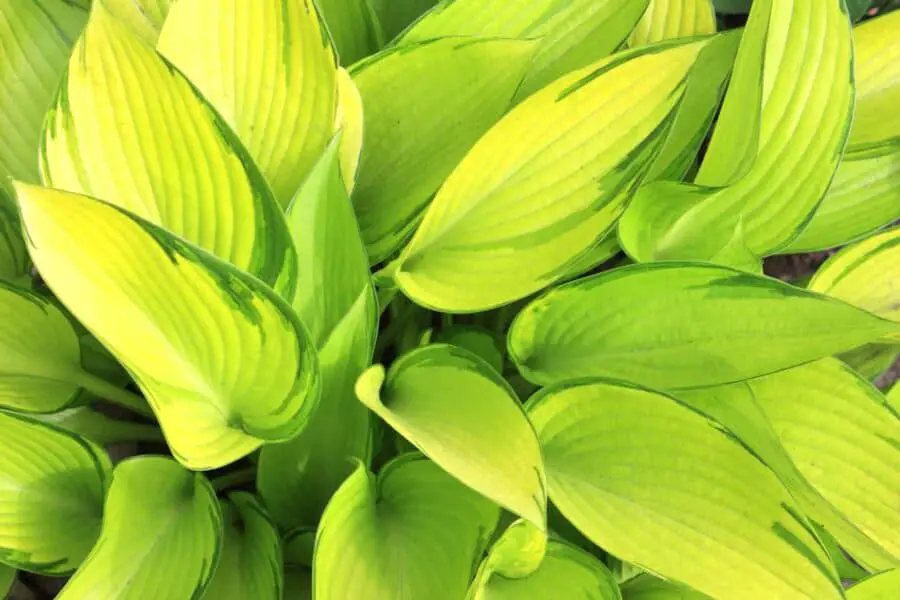
Color Changes in Yellow Hostas
Have you ever wondered why your garden seems to glow as the seasons change? Suppose you’re a hosta enthusiast like me. In that case, you might have noticed that these lush, leafy perennials have a color-changing trick up their sleeves.
Among the most captivating are the yellow or gold hostas. Their foliage can transition between different shades throughout the growing season, providing your garden with an ever-evolving display of color.
These shifts in leaf color, often shifting between vibrant green and sunny yellow hues, are not random. In fact, they have scientific names: viridescence, lutescence, and sometimes even albescence. Each process describes a different color transition that can occur in hostas leaves over a growing season.
But don’t worry, you don’t need to be a botanist to understand these terms or to appreciate the stunning color displays they produce in your garden. Let’s explore these color shifts in a simple and straightforward way for any gardening enthusiast.
Viridescence, lutescence, and albescence are fancy words that describe some fascinating color changes you might observe in yellow hostas over a growing season. Here’s a simple breakdown:
Viridescence: This term comes from the Latin word for green, “viridis.” In the context of hostas, viridescence refers to the process where leaves emerge light in color, often yellow or creamy white, and gradually turn greener as the season progresses. So, if you’ve ever noticed your yellow hostas becoming greener over the summer, that’s viridescence in action!
Lutescence: This term is derived from “luteus,” Latin for yellow. Lutescence describes the opposite process of viridescence. A lutescent hosta’s leaves emerge green in the spring and then turn increasingly yellow or gold as the season progress. So if your hostas become more yellow or golden with time, they exhibit lutescence.
Albescence: Coming from the Latin word “albus,” meaning white, albescence refers to the process where hosta leaves start off green or yellow and then lighten to a creamy white color as the season advances. This is less common than viridescence and lutescence in yellow hostas, but it still can be observed in some cultivars.
So, in short:
Viridescence turns your hostas greener.
Lutescence makes them yellower.
Albescence can lighten them towards white.
These changes can add an intriguing dimension to your garden as it evolves through the growing season!
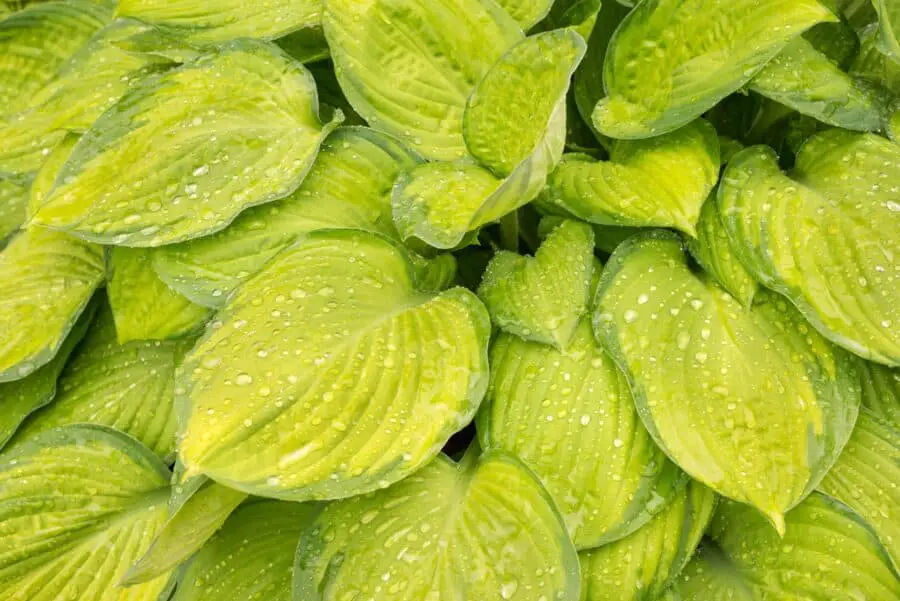
Caring for Yellow Hostas
While yellow or gold hostas share many care requirements with other hostas, there are a few specific considerations to keep in mind for these golden beauties to keep them glowing brightly.
Light Requirements
Unlike many other varieties, yellow hostas need some direct sunlight to bring out their best color. The morning sun is ideal, as it’s less intense than the afternoon sun. A few hours of the morning sun will help intensify their golden color. Dappled light throughout the day can also encourage a more vibrant hue.
Sun Protection
While yellow hostas need some direct sun to enhance their color, they also need protection from the harsh afternoon sun. Too much direct sunlight, particularly in the heat of the day, can cause their leaves to scorch or bleach out. If you notice the leaves of your hostas turning white or getting crispy edges, they may be getting too much sun.
These unique considerations will help you bring out their best colors and keep them healthy and vibrant.
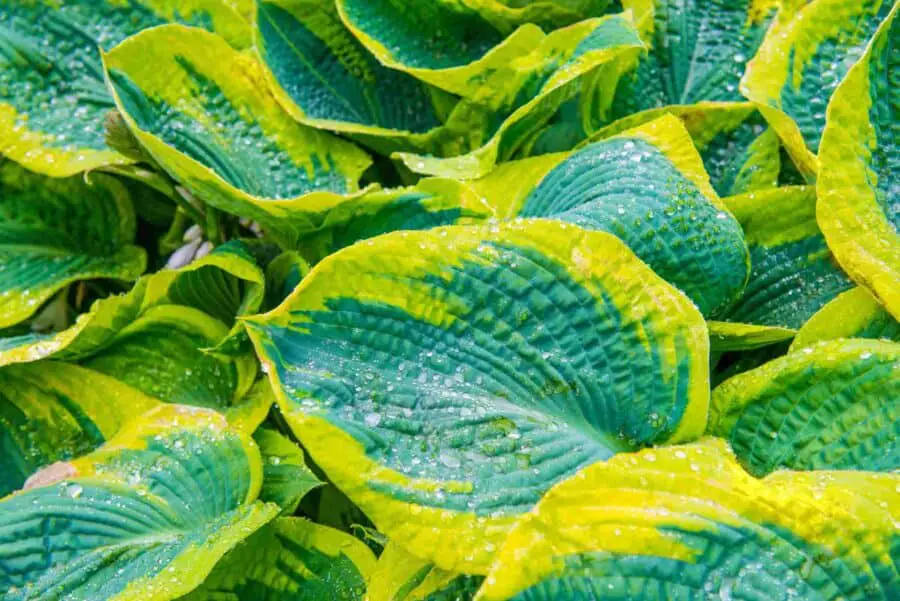
Designing Gardens with Yellow Hostas
Yellow or gold hostas are great for adding a splash of color and vibrancy to your home landscape. Here are some suggestions:
Brighten Up Shady Spaces: One of the main advantages of yellow hostas is their ability to brighten up darker, shady areas of your landscape. Consider planting them in those difficult shady spots where other plants may struggle. This is always a balancing act. You need to brighten up a darker spot and yellow hostas are at there best with a bit more sun than many other hostas. It does work well, most of the time.
Create Focal Points: Due to their distinctive color, yellow hostas can serve as excellent focal points in your garden. Plant them in a central location or a place where your eye naturally falls.
Use as Borders or Edging: The bold, broad leaves of hostas are ideal for creating borders along paths or edging around garden beds. The yellow will create a bright outline that defines and highlights these areas.
Contrast with Dark Foliage Plants: Pair yellow hostas with dark green or purple foliage, such as Heuchera ‘Obsidian’ or some ornamental grass varieties. The contrast will make both plants stand out more.
Create a Hosta Collection: If you have space, consider creating a dedicated hosta garden showcasing different varieties and colors. Yellow hostas can be used to add spots of light amongst green and blue-leaved varieties.
Remember, the goal is to experiment and find what works best in your landscape. What matters most is creating a garden you love and enjoy.
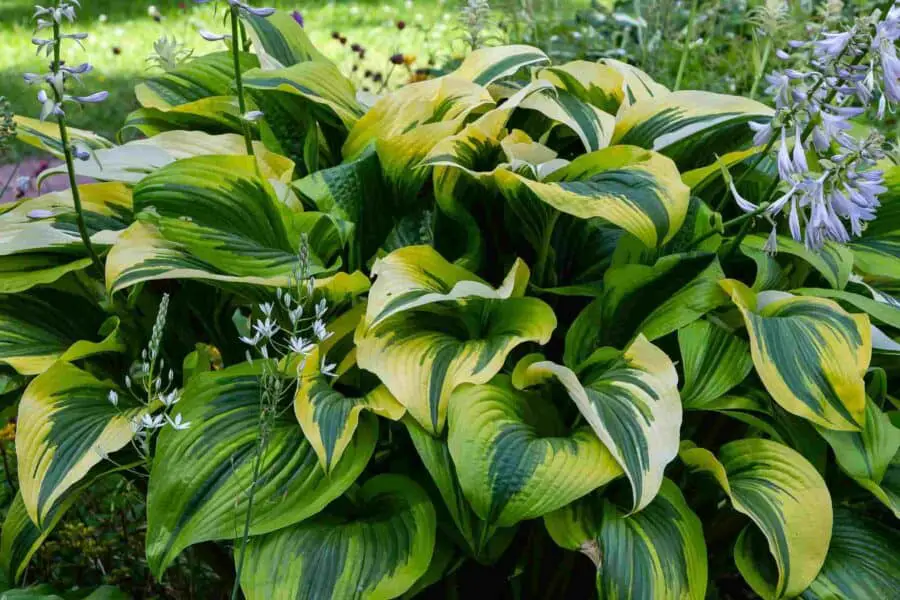
Companion Plants
Pairing yellow hostas with the right companion plants helps their golden hues shine. While many plants can complement hostas in general, here are three standout choices that remarkably enhance the beauty of yellow hostas:
Heuchera ‘Obsidian’ (Coral Bells): This variety of Heuchera has stunning, nearly black foliage that contrasts with the yellow leaves of hostas. The unique color of ‘Obsidian’ makes the yellow pop and adds a touch of drama to the garden.
Ajuga reptans ‘Black Scallop’ (Bugleweed): This low-growing perennial has glossy, near-black leaves that can contrast the bright foliage of yellow hostas. It also has blue flowers in the spring, adding another color dimension to the combination.
Athyrium niponicum ‘Pictum’ (Japanese Painted Fern): The silvery-grey fronds of this fern variety, edged in a burgundy color, contrast beautifully with the bright yellow foliage of hostas. The combination creates a soft, elegant look.
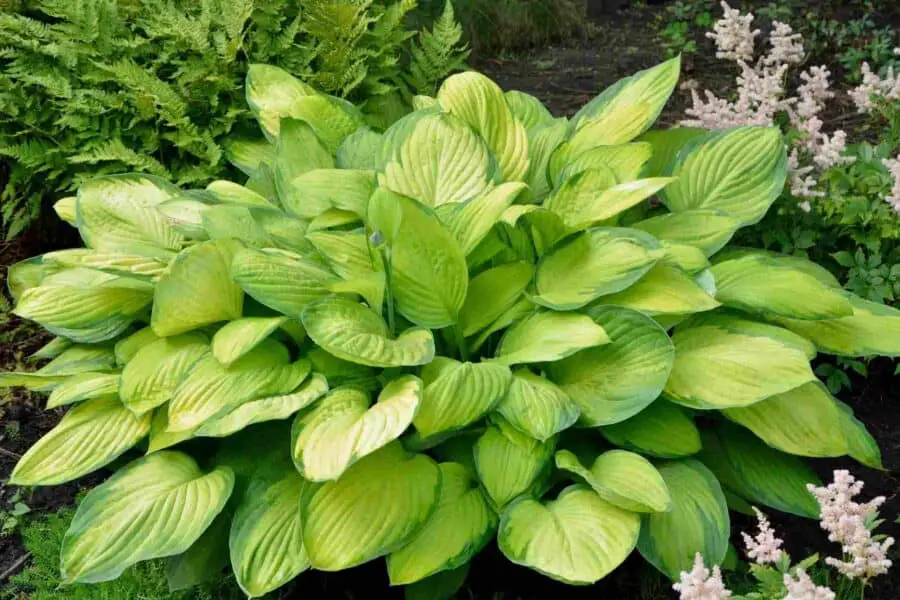
Closing Thoughts
In the heart of every garden lies an opportunity for color, and yellow hostas offer a golden opportunity indeed.
These gold-tinted gems bring a luminous vibrancy to shaded garden spots and offer a chance to experiment with design, color contrast, and companion planting.
By understanding and appreciating these golden beauties, you can transform your garden into an eye-catching landscape that continues to evolve and delight with each passing season. So why not let the allure of yellow hostas guide your next gardening adventure?
